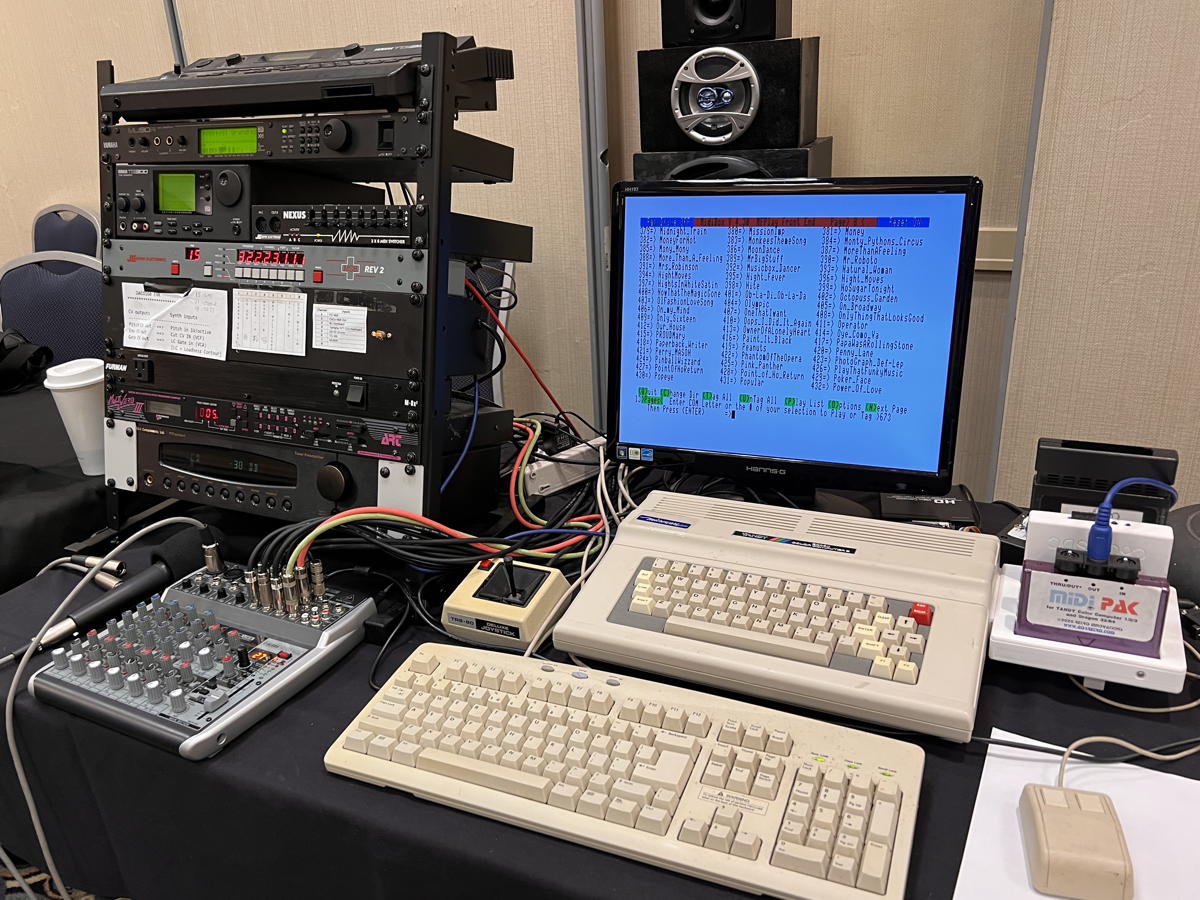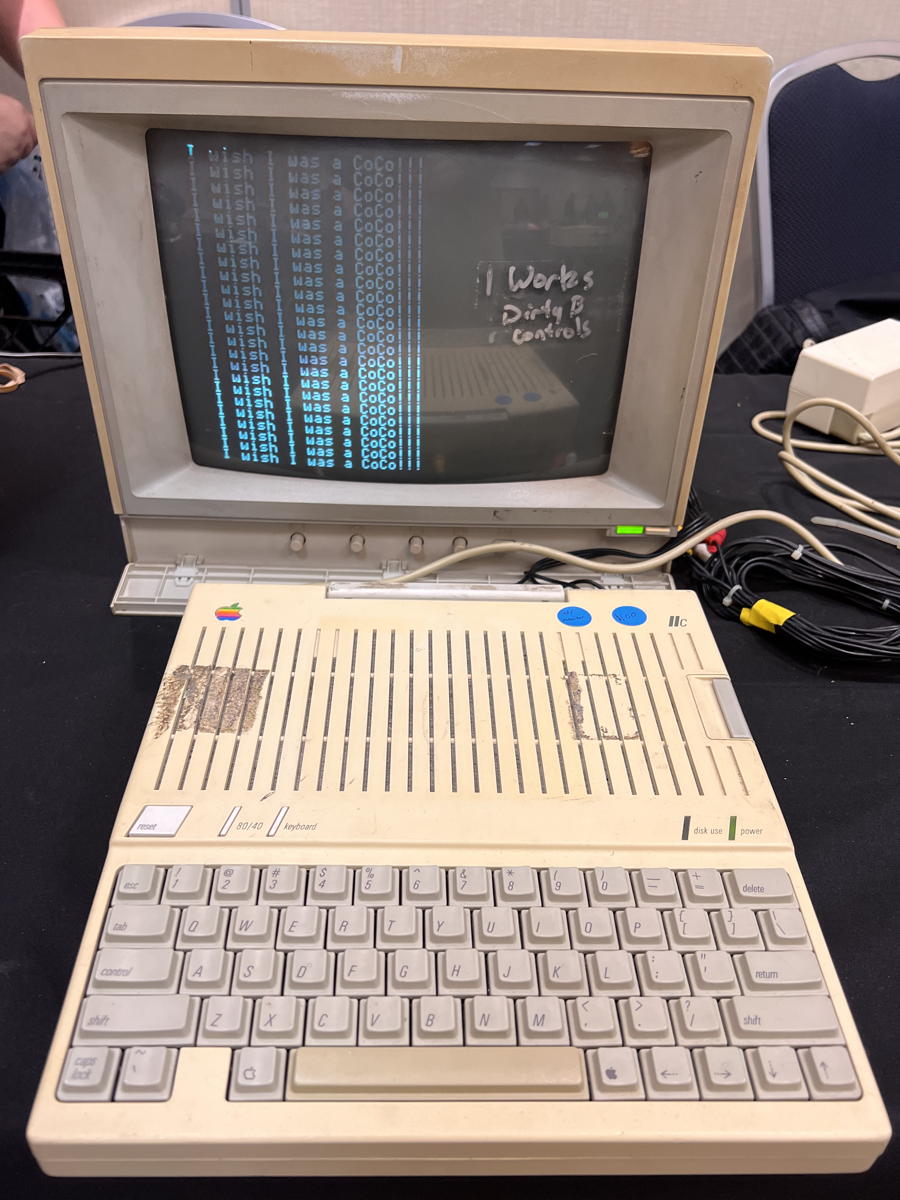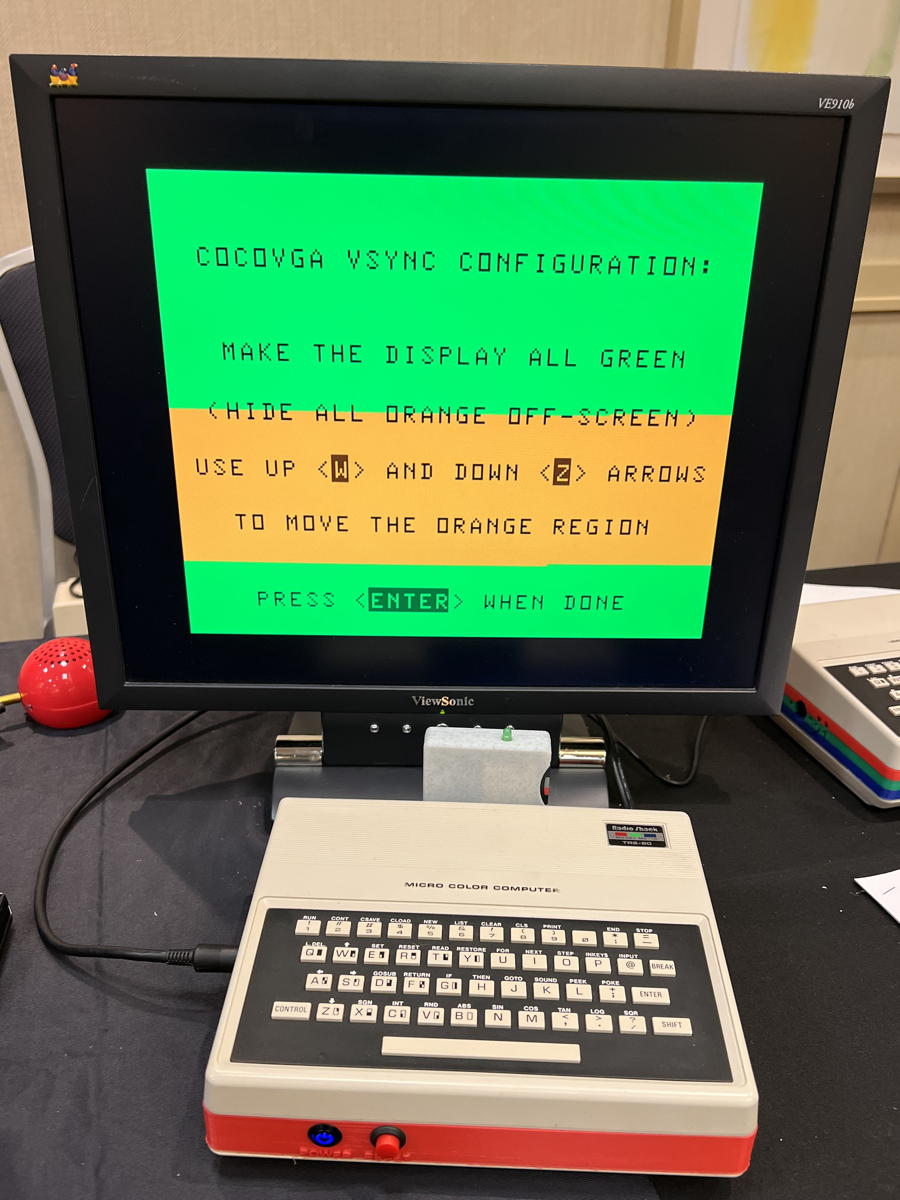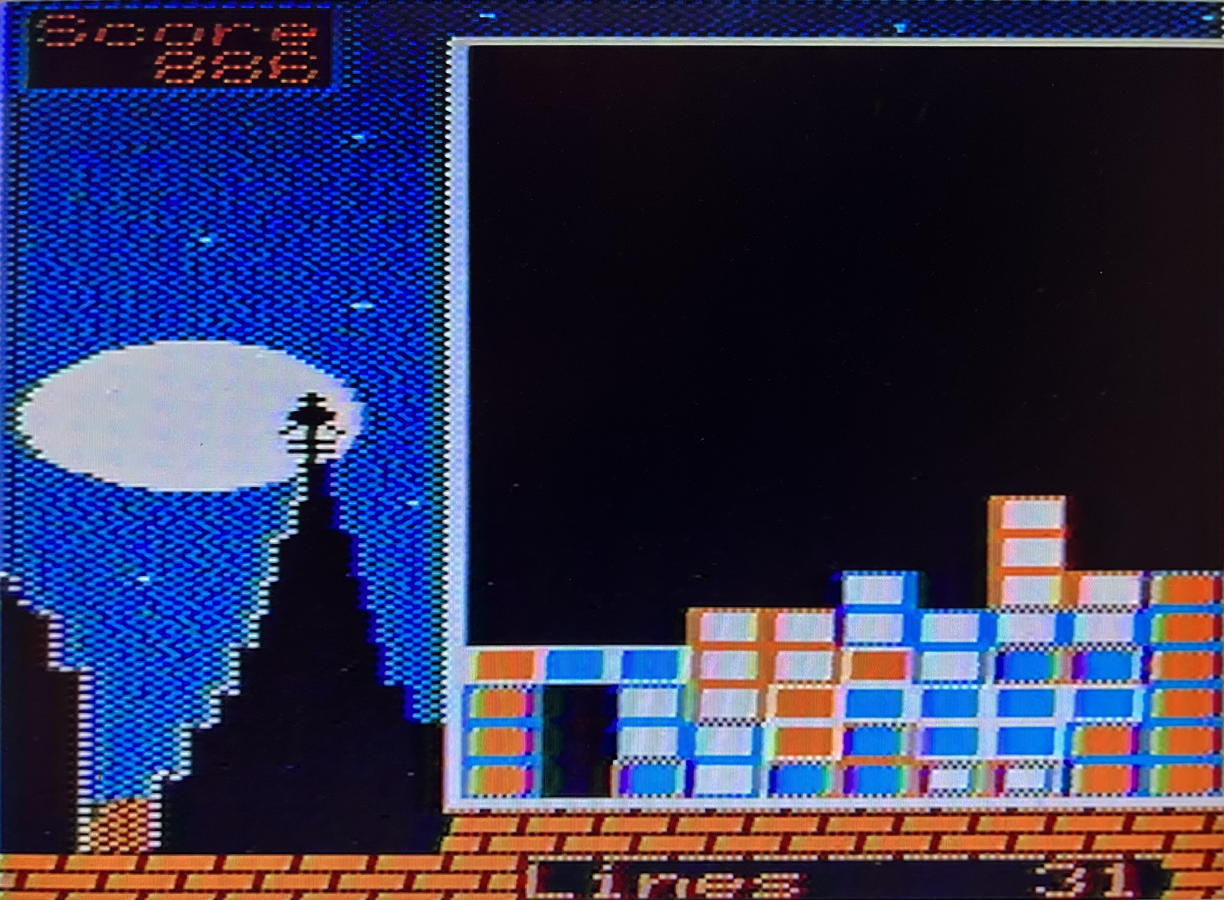CoCoFest! 2021

I started using the TRS-80 Color Computer in about 1987, and started seriously using it in about 1988. I’m pretty sure I started using the Color Computer 2: I’d been using a TRS-80 Model 1, but a house fire melted it. The computer surprisingly still worked—or perhaps unsurprisingly, the Model 1 wasn’t just battleship grey, it was built like a battleship—but was unusable and probably untrustworthy due to the damage.
One of the reasons that I never saved programs from the Model 1 was that many of the disks were damaged by water and mold. The main reason was that the programs wouldn’t work on my next computer, so why bother? Nowadays, of course, I’d just copy everything over and forget about it, but I had no hard drive then. So any disks that were working went along with the Model 1 when I sold it to someone else for parts.
I had a used Color Computer 1 or 2 that I’d acquired at some point, possibly for the hard drive that came with it. Because it was stored in a box in the closet, it escaped damage from the fire. My memory of this is very hazy, because I didn’t buy that CoCo for use. But since it was the computer I had, I tried it out, and it did what I needed it to do. At some point thereafter I acquired a Color Computer 3, probably pretty quickly, and with that, Microware’s OS-9.
OS-9 was an impressive operating system for its time, certainly compared to Windows and even compared to the Macintosh. Remember, this was the late eighties. Windows 3 wouldn’t be released for a couple of years. I quickly found OS-9 and the CoCo 3 indispensable for both programming and writing, and so I searched out support tools for it, abandoning the Model 1 line.
The biggest and best of the support tools for the CoCo 3 was Rainbow Magazine. It was as filled with great software to type in as 80 Micro had ever been—and by 1987 80 Micro was an anemic shell of its former glory. I’m not sure I was even subscribing to it at that point, as it had mostly abandoned the Z-80 line in favor of Radio Shack’s IBM semi-compatibles.

The folks at The Rainbow ran an annual tech show called Rainbowfest in Chicago1 dedicated to the Color Computer. Once I started using the CoCo as my main computer, I wanted to go. It looked like an amazing gathering of cool tech. But once I started using the CoCo as my main computer I was just out of college and living in San Diego, about as far as you can get from Chicago in the continental United States without moving to Alaska. I had neither the time, nor the funds for the flight or the hotel.
And by 1990 or so, the market for Color Computer software had waned. Radio Shack abandoned both the Color Computer and OS-9, and people began moving to other systems. Those who didn’t move already had the software they needed. Rainbow held its last Rainbowfest in 1991. The final issue of the magazine was May, 1993, by then no longer a magazine but a small broadsheet-style newspaper.

“Why is there an Apple there?”
That wasn’t the end of RainbowFest, however. CoCoFest! started in 1992 to continue the tradition. Officially titled the First annual “Last” Chicago CoCoFest, it has run almost nonstop since then. It’s now run by the Glenside Color Computer Club.
I only discovered that CoCoFest was still running recently. I no longer live in California, I have more time, and I have more funds. I signed up to go to the 29th Annual “Last” Chicago CoCoFest in 2020.
Which of course became the 29th Annual ”Last” Chicago CoCoFest in 2021. It’s run “almost” nonstop because 2020 is the only year it didn’t meet.
There was a lot of emulation there—a lot of making a Raspberry Pi physically look like a CoCo as well as emulate it. I also learned that the latest XRoar now emulates the Color Computer 3.
The auction was a lot of fun; and because there were fewer attendees this year, some people made off with seriously good deals! I finally got a legal version of Pooyan; it’s the only game I’ve been using a download for. I bought it originally while driving from Michigan to Los Angeles back in 1988. I found it in a Radio Shack I happened to stop off at, which of course made me stop off at every Radio Shack I saw from that point on, but there were no more such deals to be had. It’s a weirdly fun game. But I sold it along with my Color Computer 3 back in the early nineties.
I also picked up a pile of old game cartridge manuals, which is nice because most of the cartridges on eBay don’t come with manuals.
Outside of the auction, in the dealer room, I managed to get a copy of one of my two favorite cartridge games, Tetris.2
Also very present at the fest was the MC-10. I’d never even heard of this back in the day, but I recently acquired one by chance. It’s a weird little thing. The keyboard isn’t just annoying as a chiclet keyboard. It has an annoying layout, too. It has no arrows; a few of the letter keys double as arrows. The SHIFT key is only on the right, with the CONTROL key only on the left, making for hilarious mistypes. On the other hand, most of the keys also double as BASIC keywords. Instead of typing GOSUB, you could type CONTROL-D, for example.
Like the CoCo SDC for the Color Computer, the Zippster Zone has an MCX-32 SD for the MC-10. Besides allowing the use of an SD card, it updates BASIC on the MC-10 to come a lot closer to Extended Color BASIC. I haven’t had a chance to play around with it much yet, but it’s an invaluable tool. I have no desire to start mucking with cassette tapes and floppy disks.
One of the most amazing displays at the fest was using the CoCo VGA with the MC-10. CoCo VGA adds a much clearer display option to the Color Computer, but the MC-10 was supposedly lacking the hardware to handle it. And not supposedly—it really is lacking the hardware to handle it. But that can be fixed in software, with a little help from the human operator.

Everybody was running a display of some kind, and most of them were playing cool old 8-bit games. Some of them were running the games in emulation on a Pi; some were housing their Pi in CoCo-like enclosures. Some were making CoCo-like enclosures with 3d printers! And there were genuine Color Computers in all shades of age, from pristine white to ancient yellow.
It was a lot of fun. I went to Tandy Assembly back in 2018 because it happened to coincide with some travel in the area. That was a lot of fun too. There is great work and innovative work being done on these old computers.
In response to The TRS-80 Color Computer 2: The TRS-80/Tandy Color Computer 2 is a fascinating bit of computer history. It was the direct ancestor of the first inexpensive home Unix-like computer, the Color Computer 3.
In the earlier years, there was a second annual show in New Jersey, and in the very earlier years there were ones in other locations as well. But Chicago was always the tent pole of them.
↑The other cartridge that I played incessantly was Shanghai, the Color Computer’s version of Mah Jong. But that was only for the CoCo 3, and I have the CoCo 2. A CoCo 3 would be going too far down the vintage rabbit hole!
↑
CoCoFest
- The 3D Printed CoCo Case with John Strong: John Strong at StrongWare
- John Strong describes the process of printing cases for Color Computers, MC-10s, cartridges, and more.
- Chicago CoCoFEST! at TRS-80 CoCo Wiki
- “Glenside took over after Rainbowfests and the CoCoPRO CoCoFests stopped. To date, no one has told them to stop…”
- Everything in the MC-10 but the (Kitchen) Sync!: Brendan Donahe at Glenside Color Computer Club
- Brendan Donahe talks about using the CoCo VGA with the MC-10.
- Glenside Color Computer Club
- “Glenside Color Computer Club is dedicated to keeping CoCos and CoCo goodies out of landfills… Radio Shack and Motorola have given us these wonderful machines. Their collaboration made the CoCo the best on the market. What keeps the CoCo alive is the many folks that persist in keeping the CoCo updated with the latest technology for the best selling 8-bit machines of the past.”
- Rainbowfest at TRS-80 CoCo Wiki
- “Rainbow Magazine held the largest Color Computer Conventions.”
Color Computer
- The Rainbow at Wikipedia
- “The Rainbow was a monthly magazine for the TRS-80 Color Computer. It was started by the late Lawrence C. Falk (commonly known as Lonnie Falk) and was published from July 1981 to May 1993 by Falk's company, Falsoft, which was based in Prospect, Kentucky.”
- StrongWare: John Strong
- “Making Software Strong”.
- Tetris for the Color Computer: L. Curtis Boyle
- “Tetris is the official licensed version of the monster smash game of the 1980’s. A very addictive puzzle game.”
- XRoar—Dragon & CoCo emulator
- “XRoar is a Dragon emulator for Linux, Unix, Mac OS X and Windows. Due to hardware similarities, XRoar also emulates the Tandy Colour Computer (CoCo) models 1 & 2. More features.”
- The Zippster Zone: Ed Snider
- “Adventures in retrocomputing with the CoCo”
TRS-80
- 80 Microcomputing: Ira Goldklang at Ira Goldklang’s TRS-80 Revived
- The covers of 80 Microcomputing from January 1980 through June 1988, plus a search of the table of contents. Go ahead, search me.
- Tandy Assembly 2018
- Tandy Assembly was earlier this November, and I have never seen so many Radio Shack computers in one spot. Also, my love affair with daisy wheels is rekindled.
More Color Computer
- Simple game menu for the Color Computer 2 with CoCoSDC
- This simple menu provides one screen for cartridges saved in the CoCoSDC’s flash ROM, and any number of screens for your favorite games for your friends to play.
- Rainbow Magazine preflight tool enhanced
- I’ve added several features to the Rainbow Magazine preflight tool, including a check for references to line numbers that don’t exist.
- BASIC tokenization examined
- Why do old BASIC programs have strange characters in their .BAS files? Why do they look like they’re compiled code?
- What are the 8 bits in 8-bit computing?
- Retro computing is often called 8-bit computing. This is because the bytes that these computers use are composed of eight bits, and much of what the computer does is operating on these individual bits, not on the byte as a whole.
- The TRS-80 Color Computer 2
- The TRS-80/Tandy Color Computer 2 is a fascinating bit of computer history. It was the direct ancestor of the first inexpensive home Unix-like computer, the Color Computer 3.
- 19 more pages with the topic Color Computer, and other related pages


